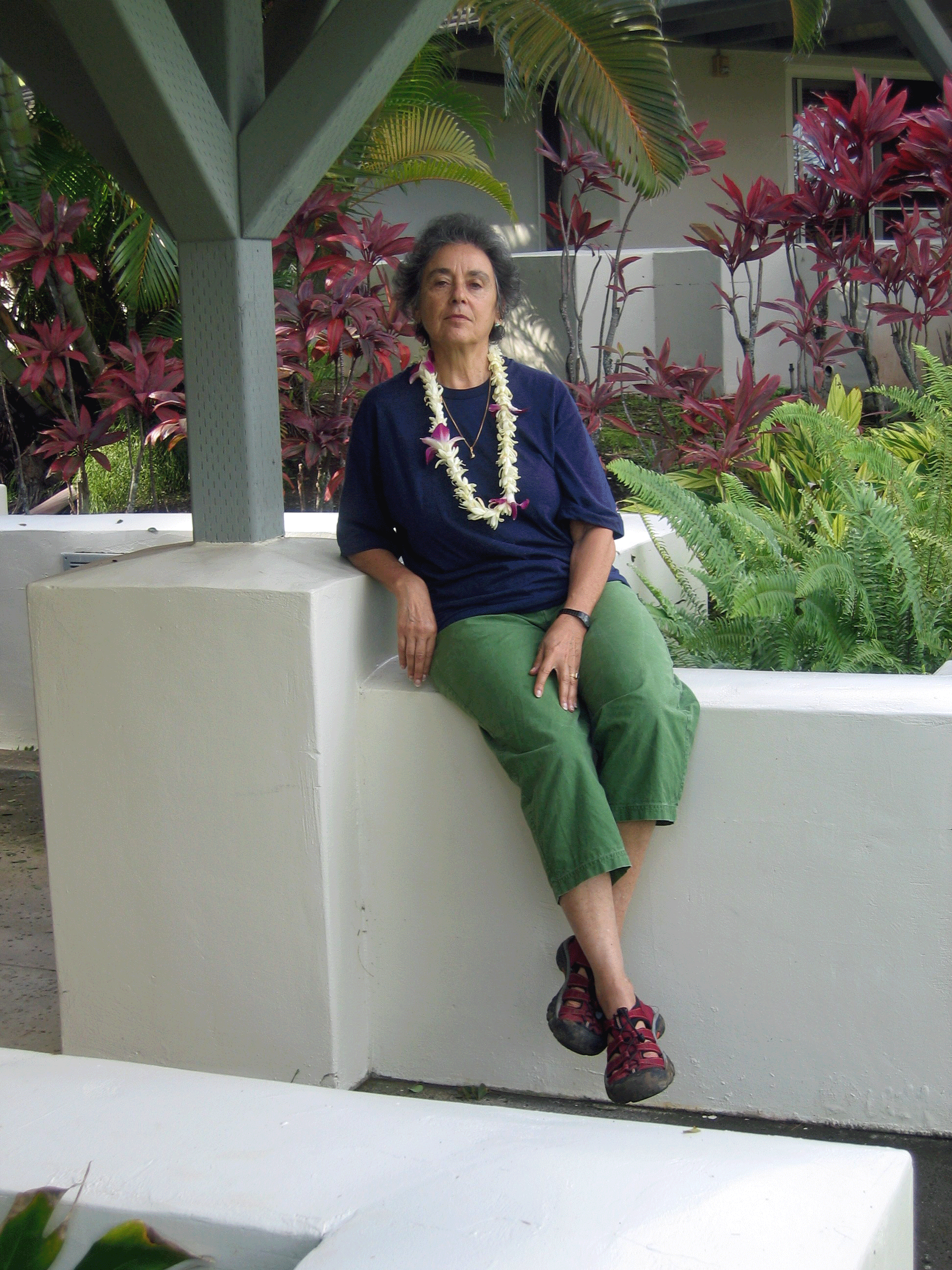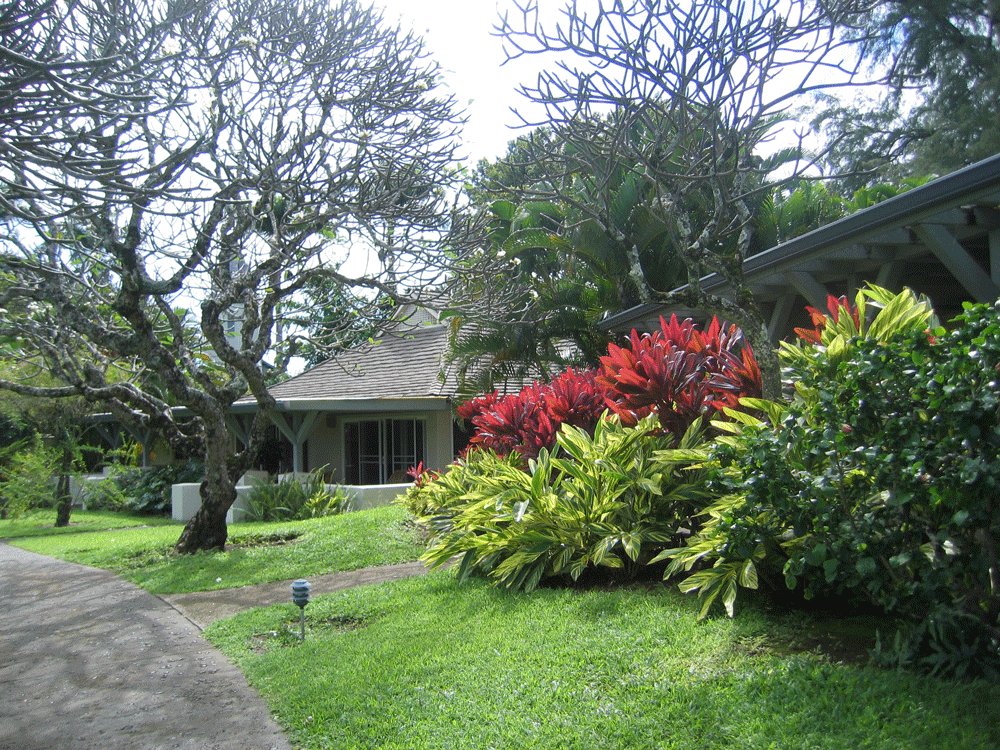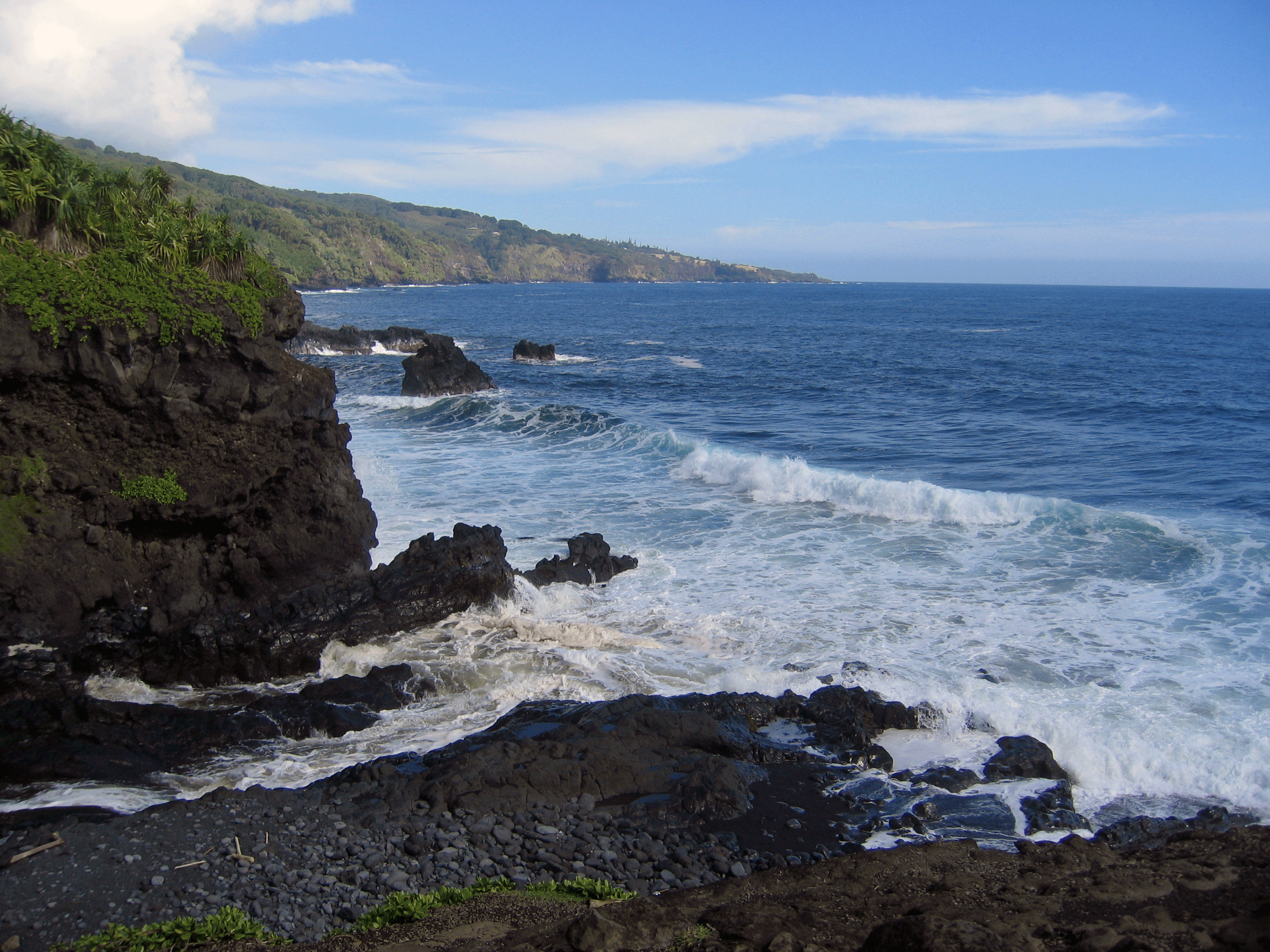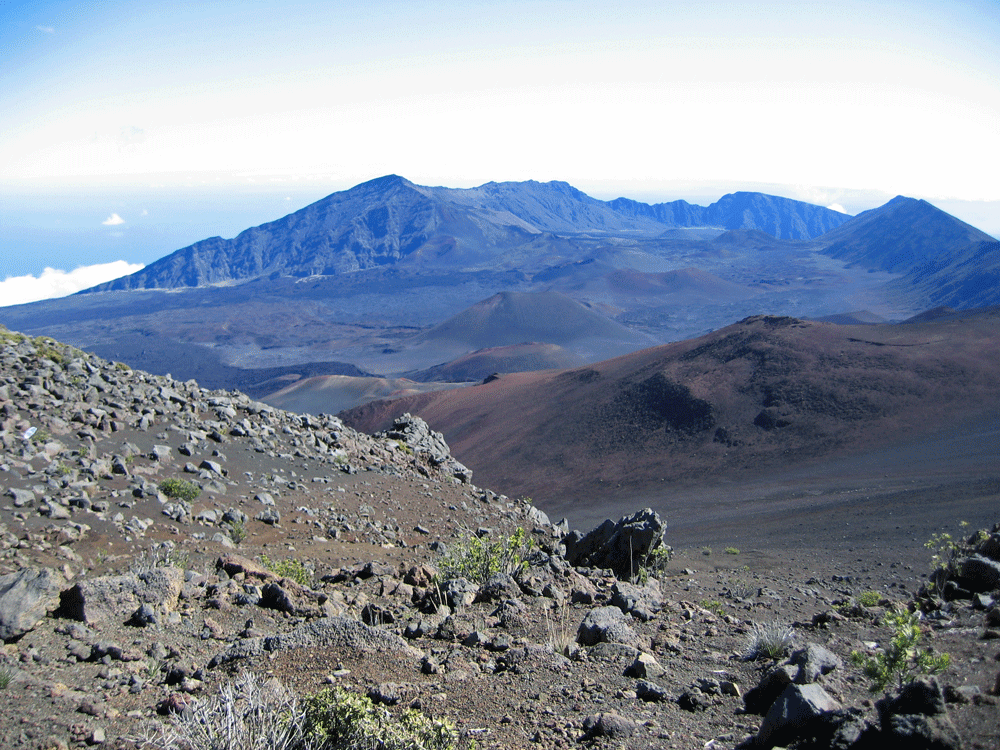You may wonder why we chose so conventional a destination as Hawaii. We had to use our UAL frequent flyer miles by the end of the year. Susan gave me the choice of going to any of the three states she had not yet visited. The other two were Mississippi and Alabama.
The Hawaiian islands are the most isolated in the world. They are volcanic and growing, but will disappear eventually. They are about 5000 miles from the NYC area and five time zones earlier. There are a few non-stop flights, but we changed in LA outward and in San Francisco coming back. Each economy passenger is permitted 50 pounds of checked bags, but if, like us, you take but a single suitcase of 53 pounds, you are reprimanded, particularly if “flying over the water.”
We arrived in Honolulu in time for two major events: the holiday parade and the football game. The local university team had won all 11 of its matches going into the final with Washington. A victory promised a Bowl invite. Washington seized a 21-0 lead. They were still a touchdown up when we tuned in. But, amid the greatest excitement, the locals grabbed two more touchdowns and headed for the Sugar Bowl. (The satirical NYC paper The Onion alleged that the team had got there with four wins each over [non-existent] Hawaii State, South Hawaii and Hawaii A & M.)
The next day, Sunday, the city had calmed down. we rented a car for $40, which is the cost of a cab from the airport. It was a strange vehicle, of indeterminate manufacture, half car, half jeep, with rear window spaces that do not close. The rear seats were wet from the previous day’s rain, but no matter. We drove around most of the island (Oahu), which is easy because the roads are good and the island is small. We stopped at Hanauma Bay (very blue and pretty) and Punalu’u Beach Park--good for swimming if you don’t go out too far. Ten dollars bought lunch for two from one of the many trailer that specialize in fish.
We spent only a couple of days in Honolulu. Waikiki, where we stayed in the (relatively) low budget Hawaiiana hotel. Waikiki consists almost entirely of high-rise hotels and pricey shops. But at least it is a beach. The most popular destination is Pearl Harbor, about six miles west of town. The island is served by buses, known as TheBus. They cost two dollars exact cash (just a buck for old people like me). There are many TheBuses, but only #20 goes to Pearl. And not too often at that. The trip took over an hour. The folks at Pearl are understandably worried about an sequel to December 7, 1941. You are not only forbidden to bomb battleships--you can’t bring in any closed containers. Cameras are OK, but not camera cases. After watching a documentary film about the attack, you are ferried out to the Arizona memorial. It is a quiet white rectangular structure straddling the sunken ship, on which over 1100 men died. The deck is visible under ten feet of water. It is very quiet and spooky. Battleship Row is deserted now, but we could picture the eight giant ships anchored here, in peace and vulnerability, nearly 66 years earlier.
Two other stops: Chinatown for lunch, and the splendid Hawaii State Art Museum.
Then to our next and final island, Maui. We flew there on a 737. There are two stages to the half hour flight: climbing to altitude and descending from it. Transport is the biggest source of controversy in the islands. Should high-speed ferries be permitted? They would likely reduce air traffic, but might encourage tourism and development. The two sides are virulent.
From the NY Times, Sept. 4, 2007:
A giant twin-hulled ferry designed to transform transportation between the Hawaiian Islands for tourists and residents made its maiden voyage on Aug. 26.
But today, the $85 million boat, the Alakai, lies idle in the harbor here [Honolulu], prevented by court order from sailing to Maui and by protesters from going to Kauai. A citizens group there was preparing to ask a judge for a similar order. “The law requires the Superferry to prove it’s safe,” said Daniel Hempey, the group’s lead lawyer. The luxurious 450-foot ferry, thought to be the largest aluminum ship ever built in the United States, would be the first to carry cars (up to 286), trucks and 866 passengers between the island of Oahu, Honolulu’s home, and two neighbor islands, Maui and Kauai. The ferry was not running while we were there, but seemed poised for resumption, despite the destruction by storm of one of its piers.
Maui is slightly bigger than Oahu, but nevertheless small. Hard to negotiate carless. We rented a two-door Ford Mustang, the smallest option. Our first stop was Hale Ho’oikpa Inn in Makawao, a half hour away in what is called the Upcountry. This very pleasant B & B is run by Cherie Mattix, who had lived in Maui for a long time. She knew the local weather. “If you want to see the Halekala volcano, go tomorrow, before the storm comes in.” So we did.
Hawaiian volcanoes are the “shield” variety--long and gentle rather than steep and jagged. You drive past the national park entrance to the visitor center at 9500 feet, 500 feet below the summit. Then walk down the gentle horse path (unappealingly called the Sliding Sands Trail) down to the flats at 7000 feet. The lunar landscape is spectacular, barren, orange-brown. No greenery higher than shrubs. The sky was solid blue. The few hikers behind us dropped away, but we passed four workers splitting rocks to ease the footing for the horses. At 12:30, realizing that the return trip would be all uphill, we turned back. Within an hour clouds had dropped around us, cutting the visibility a few hundred feet. A gusty wind had a chilling impact. After a time Susan, always the faster going up, had vanished into the mist. I called out for her and was relieved to see her heading back toward me. Only she wasn’t Susan but Neesa (possibly Nisa), an independent young woman who had hitch-hiked up to the trailhead. She informed me that I had missed a trail fork, so I accompanied her back to the main trail. The higher we climbed, the more furious the wind. You could stay upright by leaning into it, but then you would teeter when the blast suddenly stopped. We were being lashed by rain and hail. I was glad that Susan was safely ahead.
Neesa and I reached the parking lot about 3:15. The foul conditions had propelled us to a rapid ascent. I looked for Susan in the Mustang, but it was locked, and she had our only key. The ranger station was shut down. Neesa searched the women’s room, but no Susan. I tried her cell phone, without response. I wrote out a distress note for a driver headed down toward civilization and wondered how long it would take to mount a search. How could this be happening?
Ten minutes later, Susan appeared, after what she calls the worst two hours of her life. She was sure that I had been felled by a broken leg or heart attack and was expiring in the wilderness. But how had she got behind me? As follows: in the very five minutes that I was on the wrong trail, she turned back (on the right trail, of course) to find me. But I had got back on track while she was still looking.
So we had found that even in Hawaii, hiking has its risks. To be sure, the weather was abnormal--Cherie said the next day was one of the worst she had seen in 15 years. That didn’t stop a 67-year-old grandfather from attempting the summit of Mauna Kea. At nearly 14,000 feet, it is the highest point in the Pacific. Five days later there was no sign of the man. News report: “The ranger advised Murphy, who was alone, not to go hiking because of the terrain and the cold weather, Kojima said. Murphy left about noon, leaving his car at the Onizuka Center for visitors at the 9,000-foot level... A ranger, who was the last person to see him, said Murphy was wearing only a light shirt and slacks -- ‘street clothes,’ as Kojima put it.”
(Yes, we had warm clothes, a whistle that Susan reprimanded me for not using, and a compass.)
The night after our adventure, the wind rattled the windows all night. The next day was very wet and gusty. Many parts of the island lost electricity.
Cherie advised us to stay home. We did, along with the other guests, a New York couple (upper West Side Jewish, naturally) and a man working on his laptop. He was joined by two colleagues, refugees from their power-deprived lodging. They were at their keyboards well into evening. Hard to know what they were doing:
--We work for the government. Up on the mountain.
--Doing what?
--There’s a lot of science going on on that mountain.
We figured them for Dept. of Defense, or possibly CIA.
Despite the rain, blowing in at a 45 degree angle, we and the Manhattan couple drove to town (two minutes) for an emergency lunch of burritos and margaritas. We went back to town to dinner. That was it for the day.
The volcano adventure was the high and low point of the trip. We spent four days at the Hana Maui Hotel, on the east end of the island. We drove there on the once-notorious Hana Highway. It is now a well paved road, but has about 600 curves and 50 one-lane bridges in its 40-plus miles. It’s also very pretty.
The Hana Maui is a resort, which means that it is comfortable and expensive. They give you free soda in your mini-bar and promise “not to nickel-and-dime you.” Larger denominations are another matter. It’s still fairly reasonable by resort standards. Free yoga classes every morning, 7:30. (I did participate in three of these.) We had a lovely little horse ride by the ocean. My horse was docile, but hungry. I was told to restrain him: “Once he starts to eat, his working day is over.” Our guide was about to take her first trip to the mainland. She had won a trip to Las Vegas. We hope she behaved sensibly.
Sporadic tropical rain prevailed. We did get to the beach once or twice. We also drove south a few miles for a brief, highly recommended hike to the Makahiku and Waimoku waterfalls. The latter is 400 feet high. It’s a moderate hour to the falls, through some thick bamboo forests.
After four resort days, we drove back to central part of the island. The logical route is to head south and east, but the very rocky road has been closed by an earthquake. So we had to reverse the Hana Highway, which seemed a bit more manageable this time. The weather had finally cleared. We arrived at our last stop, the Old Inn at Wailuku. It was a hotel-like B & B--pretty impersonal. We were greeted by an inter-com voice saying it would see us at breakfast the next day (very tasty, by the way). We spent our last full day like normal people at the beach at Kaanapali, on the west coast.
Our greatest good fortune (apart from getting out of the volcano) was flying back to Newark from San Francisco, Dec. 13. By mid-morning most flights to the northeast had been canceled because of foul weather in the region. United Airlines paid no attention and got us back ahead of schedule.


Return to travel page.
Return to home page.

